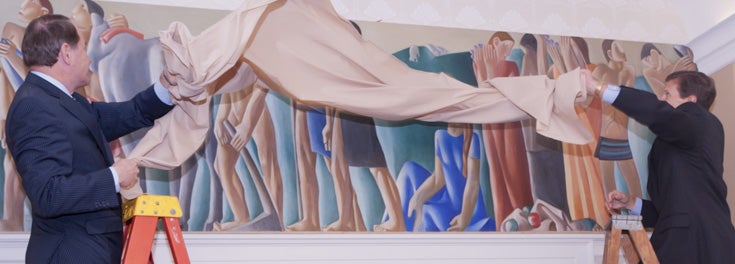
Research at URI often uncovers some big surprises. But this year it was a simple renovation at one of the University’s oldest buildings, Edwards Hall, that resulted in one of the most historic findings — a series of Depression-era murals that art historians and others had thought were long gone.
As a $1.5 million summer building renovation was underway, workers discovered several oil-on-canvas paintings beneath layers of paint and plaster in the lobby. The murals had been created in 1941 by Rhode Island artist Gino Conti (1900-1983) as part of the federal Works Progress Administration program that provided jobs and more to boost the economy during the 1930s and 1940s.
Historic artifacts remind us of the difficulties and triumphs of a most challenging time in the nation’s history.
“We celebrate the return of historic artifacts that remind us of the difficulties and triumphs of a most challenging time in the nation’s history. This artwork, commissioned at a time when our country had to come together to solve overwhelming problems, reminds us that unity of purpose and respect for all are the keys to solving the sometimes daunting problems of today,” said URI President David M. Dooley.
After the murals had been uncovered in July 2010, URI hired an art conservation company to remove and restore the canvasses. They were re-installed in the fall of 2011. A well-known Rhode Island and regional artist who had come to the United States from Italy with his parents, Conti’s murals depict allegorical scenes having to do with progress, education, multicultural heritage and the values that can be imparted through education.
Art Professor Ron Onorato, who had once interviewed the artist, was among the many who were excited by the discovery. “It is a thrilling and historically important find. These are part of our and national and campus heritage. To have this reappear adds to the relatively small number of works that exist on walls in public spaces from the period. What a great opportunity for our students to be able to learn about and see relics from the nation’s past.”
Ironically, a federal grant from the 2010 American Recovery and Reinvestment Act, designed to lessen the suffering of what many have called the worst economic crisis since the Depression, was in fact responsible for this dramatic discovery of Conti’s murals.
